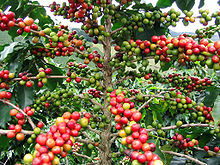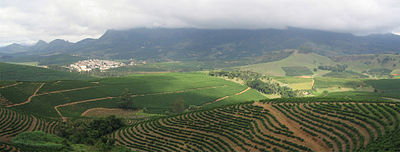Arabica coffee
| Arabica coffee | ||||||||||||
|---|---|---|---|---|---|---|---|---|---|---|---|---|

Arabica coffee ( Coffea arabica ) |
||||||||||||
| Systematics | ||||||||||||
|
||||||||||||
| Scientific name | ||||||||||||
| Coffea arabica | ||||||||||||
| L. |
Arabica coffee [ araːbikakaˌfeː ] ( Coffea arabica ), also Berg coffee or Java Coffee called, is the most economically important plant species of the genus coffee within the family Rubiaceae (Rubiaceae).
description
Appearance and leaf
Coffea arabica grows as a shrub or tree and reaches a maximum height of almost 5 meters. The constantly against arranged on the branches leaves are about 1 cm long-stalked. The dark green, glossy leaf blade is mostly 5 to 20 cm long-elliptical or obscured-lanceolate-elongated with a pointed to pointed upper end and a pointed blade base. The raised central rib on both leaf sides has 7 to 13 lateral nerves on both sides.
Inflorescence and flower
In the leaf axils there are some short, zymous inflorescences , each containing about three flowers. The supporting sheet is deltoid with a length of about 3 mm. The flower stalk is about 4 mm long. The fragrant flowers are hermaphroditic and usually five-fold. The almost always five white petals are 7 to 10 mm long. The anthers are 7 to 8 mm long.
Fruit and seeds
The so-called "coffee cherry" is an ellipsoidal or elongated, red stone fruit when ripe , with one to five chambers, but predominantly two to three chambers. Their seeds are the so-called coffee beans . In a fruit there are usually two seeds that have a curved gap on their flat side.
Chromosome number
The number of chromosomes is 2n = 22 or 44.
Cultivation
The main areas of cultivation of Arabica coffee are between 23 degrees north and 25 degrees south latitude of the equator.
Arabica is mainly grown in the highlands, ideally over 1,000 meters of altitude. This means that the coffee beans grow more slowly than with Robusta coffee. The typical ripening time is around 9-11 months.
Distribution and ecology
Coffea arabica originally comes from southwestern Ethiopia and emerged 10-15,000 years ago as a hybrid of Coffea eugenioides and Coffea canephora . Due to environmental changes, scientists fear that the wild plant population in Ethiopia could decline by 85 percent by 2080. Many cultivars are grown today in numerous tropical and subtropical countries. However, when grown at low altitude and under high temperatures, the plant is very susceptible to coffee rust .
The plant lives in symbiosis with arbuscular mycorrhizal fungi .
Legend
It is reported that a shepherd in the kingdom of Kaffa saw a goat become restless and insomniacs as soon as it had eaten the leaves and seeds of an evergreen bush. He told this to monks who have since used this plant to lengthen the vigil .
history
Presumably, the use of the plant as a luxury food is older than Ethiopian Christianity. First, tea was made from the leaves of the plant, as it is still popular today in parts of southern Ethiopia. Unroasted coffee beans are sour and not very aromatic, which is why they were initially disregarded. Presumably in Yemen , where Sufis used coffee to prepare a drink to keep them awake, roasting and grinding beans was discovered as a drink base much later . From Yemen, coffee spread to the Arabian Peninsula from the 15th century. First with the Egyptians and later with the Turks , drinking the stimulating drink, formerly known as “Arabic coffee”, became a habit and part of their culture. Since Dutch seafarers brought the coffee bean to what is now Indonesia at the end of the 17th century , Arabica coffee is also called Java coffee , although some of the finest varieties of 100% Robusta coffee are traded under the name “Coffee from Java” .
use
Coffee is one of the most popular beverages in the world. Arabica is considered to be the finest bean and almost all top-quality coffees are made from pure Arabica. However, only about 5% of the beans produced are high quality. 100% Arabica is no guarantee of quality and you can also find cheap coffee advertised as pure Arabica in the supermarket. Because of its higher price, Arabica is preferred in cultivation and is now grown in small plantations in most tropical countries for export purposes . In contrast to the more heat-resistant and faster-growing plant type Robusta coffee , the Arabica bean is characterized by a more noble taste and significantly lower caffeine content . The main buyers are the countries of temperate zones. Coffee is a major commodity worldwide and forms the basis of the local economy in some producing countries.
Brazilian biologists have naturally found low-caffeinated Ethiopian coffee plants. While the conventional Coffea arabica contains 12 milligrams of caffeine per gram of dry weight, the low-caffeine one has only 0.82 milligrams. By using these plant selections, the decaffeination process customary in the industry could be avoided.
The coffee charcoal is used medicinally, among other things, for diarrheal diseases . Coffee carbon is created by roasting the beans almost until they are completely charred.
Systematics
The first publication of Coffea arabica was carried out in 1753 by Linnaeus in Species Plantarum , 1, p 172. Coffea arabica belongs to the subgenus Coffea in the genus Coffea .
literature
- Hans Becker , Volker Höhfeld , Horst Kopp : Coffee from Arabia. The change in the meaning of a world economic good and its settlement-geographical consequence on the dry line of ecumenism. (Series: Geography Knowledge. Series of publications for research and practice. Issue 46). Wiesbaden 1979.
Individual evidence
- ↑ a b c Coffea arabica. In: PIER = Pacific Island Ecosystems at Risk . Retrieved October 26, 2011 .
- ^ Coffea arabica at Tropicos.org. In: IPCN Chromosome Reports . Missouri Botanical Garden, St. Louis
- ↑ a b Till Stellmacher, Governing the Ethiopian Coffee Forests - A Local Level Institutional Analysis in Kaffa and Bale Mountains , Dissertation University of Bonn 2007 ( online version (PDF; 3.7 MB) ), p. 82
- ^ Julian Siddle, Vibeke Venema: Saving coffee from extinction , BBC World Service, May 24, 2015
- ^ E. Sieverding, J. Friedrichsen, W. Suden (1991) Vesicular-arbuscular mycorrhiza management in tropical agrosystems special publication by GTZ (Germany).
- ^ Annerose Menninger: Enjoyment in cultural change. Tobacco, Coffee, Tea and Chocolate in Europe (16th – 19th Centuries). Stuttgart 2004, p. 85 f.
- ↑ Viviane Deak, Yvonne Grimm, Christiane Köglmaier-Horn, Frank-Michael Schäfer, Wolfgang Protzner: The first coffee houses in Würzburg, Nuremberg and Erlangen. In: Wolfgang Protzner, Christiane Köglmaier-Horn (Ed.): Culina Franconia. (= Contributions to economic and social history. Volume 109). Franz Steiner, Stuttgart 2007, ISBN 978-3-515-09001-8 , pp. 245-264, here: p. 246.
- ↑ What is the difference between Arabica and Robusta coffee? Retrieved April 9, 2015 .
- ↑ Maria B. Silvarolla, Paulo Mazzafera & Luiz C. Fazuoli: A naturally decaffeinated Arabica coffee . In: Nature , Volume 429, June 2004, p. 826. doi : 10.1038 / 429826a
- ^ Entry at tropicos.org
- ^ Coffea arabica. In: GRIN = Taxonomy for Plants. Retrieved October 26, 2011 .



